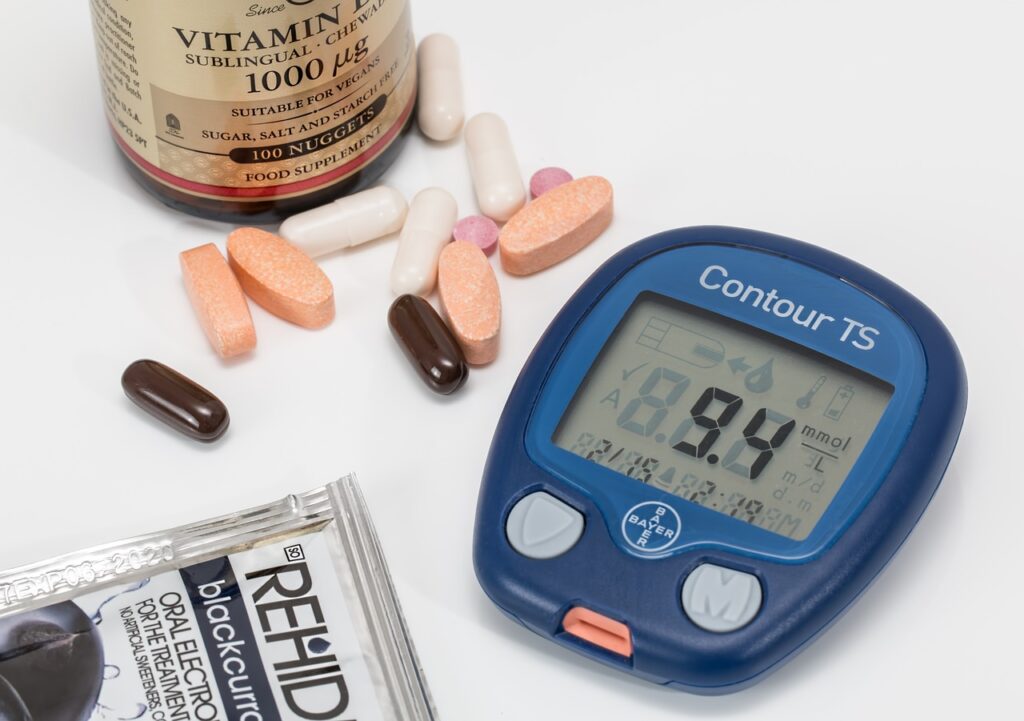7 Steps to Effective Diabetes Control and Healthier Living
Learn how to control diabetes and live healthier! Check out the 7 Steps to Effective Diabetes Control and Healthier Living.
With practical tips on diet, exercise, and monitoring, you can improve your quality of life and avoid complications. Discover how small changes in your daily routine can make a big difference for those living with diabetes.
The causes of diabetes are not completely understood by science, but it is known that a healthy lifestyle, which includes good nutrition and physical exercise, helps prevent the disease.
Diabetes is a disease capable of causing many other types of problems, including heart and arterial complications, vision loss, and problems with the kidneys and nervous system.
More serious cases where the disease spreads uncontrollably can lead to death. Let’s understand how this disease happens and what are the forms of prevention and treatment.
What is diabetes?
When the body cannot produce enough insulin or cannot absorb the insulin it needs, the diagnosis may be diabetes. Insulin is the hormone responsible for regulating blood glucose levels, generating energy for the body as a whole. If insulin levels are higher than expected, these high levels can cause a variety of health complications.
There are two types of diabetes: type 1, hereditary, present in 90% of cases, and type 2. For both cases there is no cure for the disease, but there are several forms of control that can help the patient to have a better life. relatively normal and practically without symptoms.
Type 1 diabetes usually manifests itself in adults, but can be diagnosed in childhood and adolescence, and is characterized by irregular insulin production. As it is a hereditary disease, children of diabetic parents should be extra careful and have blood tests at least once a year.
Healthy lifestyle practices help to prevent the manifestation of the disease. However, once the problem is diagnosed, it may be necessary to use insulin or controller medications daily for the rest of your life, in addition to diet modifications so that sugar consumption is as low as possible.
Type 2 diabetes is diagnosed when the body is able to produce the insulin it needs, but does not absorb it properly. This condition is not hereditary, but caused by a sum of factors such as overweight, sedentary lifestyle, high levels of triglycerides caused by poor eating habits and hypertension.
Essential Changes to Control Diabetes: 7 Key Points
Effective diabetes control can be a complex process and often requires significant lifestyle changes and appropriate medical treatments. However, there are some key points that can help prevent, control or even eliminate diabetes. Here are seven of those points:

Healthy eating
Following a healthy diet is one of the main factors in controlling diabetes. The diet should be rich in whole foods, fiber, vegetables, and legumes, and limit the consumption of sugar, saturated fats, and processed foods.
Following a healthy diet is one of the most important factors in controlling diabetes. The goal is to achieve a balanced and varied diet, rich in nutrients and low in calories, that helps keep blood sugar levels within healthy limits.
People with diabetes should eat a variety of foods from all food groups, including fruits, vegetables, whole grains, lean proteins, and healthy fats. The emphasis should be on eating foods rich in fiber, as this can help slow the absorption of sugar into the bloodstream.
It is also important to limit or avoid certain foods that can cause blood sugar levels to rise quickly. This includes foods high in simple carbohydrates and sugars, such as processed foods, sugary drinks, sweets, and desserts.
Here are some tips for healthy eating to help control diabetes:
Choose whole grain foods: Whole grain foods are foods that have not been processed or refined. They are generally more nutrient dense and contain more fiber than processed foods. Examples of whole-grain foods include fruits, vegetables, nuts, seeds, whole grains, and lean proteins.
Focus on fiber
Fiber is an important nutrient that can help regulate blood sugar levels. Good sources of fiber include fruits, vegetables, whole grains, legumes, nuts, and seeds.
Limit processed foods: Processed foods are usually high in added sugars, salt, and unhealthy fats. They can cause spikes in blood sugar levels and should be limited or avoided as much as possible.
Watch your carbohydrate intake: carbohydrates are broken down into sugar in the body, so it is important to monitor your carbohydrate intake. Good sources of carbohydrates include whole grains, fruits, vegetables, and legumes.
Weight loss
Weight loss can help decrease insulin resistance and improve the sensitivity of cells to insulin, reducing blood sugar levels.
How to Lose Weight Fast in 3 Simple Steps
Exercise
regular physical activity can help control blood sugar, as well as help reduce the risk of cardiovascular complications and improve insulin sensitivity.
Yes, regular physical activity can help control blood sugar, especially in people with diabetes or pre-diabetes. When you exercise, your muscles use glucose for energy. This helps reduce blood sugar levels, because the sugar is taken from the blood and used by the muscles.
In addition, regular physical activity can increase sensitivity to insulin, which is a hormone that helps control blood sugar levels. With increased insulin sensitivity, your body is able to use insulin more efficiently to get glucose into the body’s cells, where it is used for energy.
It is important to remember that before starting any exercise program, especially if you have diabetes, you should consult your doctor to verify that it is safe and appropriate for your condition.
In addition, it is important to monitor your blood sugar levels before, during, and after exercise to ensure that they are within the safe range.
Medications
taking doctor-prescribed medications may be necessary to control blood sugar levels. This may include insulin injections, oral medications, and other specific treatments.
Stress management
chronic stress can affect blood sugar levels, so it is important to learn to manage stress through techniques such as meditation, deep breathing, and yoga.
Frequent monitoring
it is important to regularly monitor blood sugar levels and control them according to medical recommendations.
Potential Benefits of Supplementation in Diabetes Management
For individuals with type 2 diabetes, managing blood sugar levels through diet, exercise, and medication is critical. Some people, however, look for additional ways to support their health, such as with supplements. One such option is GlucoTru, a natural formula that may help improve blood sugar regulation and metabolic health.
Key ingredients in GlucoTru include:
- Alpha Lipoic Acid (ALA): A powerful antioxidant that may enhance glucose uptake in muscle cells, reducing oxidative stress and protecting against diabetes-related complications.
- Banaba Leaf Extract: This contains corosolic acid, which helps improve glucose absorption, lower blood sugar levels, and has anti-inflammatory and antioxidant properties.
- Licorice Root: Known for its anti-inflammatory and antioxidant effects, licorice root can help improve insulin sensitivity and digestion.
- Chromium: A key mineral for carbohydrate and lipid metabolism, chromium enhances insulin activity and helps maintain normal blood sugar levels.
- Zinc: Essential for insulin production and glucose metabolism, zinc also supports immune function and overall metabolic health.
While GlucoTru offers these potential benefits, it is important to remember that it is not a substitute for traditional diabetes treatments like prescribed medications, diet, and exercise. It is intended to complement these approaches by supporting healthier blood sugar levels, reducing sugar cravings, and promoting weight loss.
As with any supplement, it is advisable to consult a healthcare professional before starting GlucoTru, especially if you are managing diabetes or other chronic conditions.
GlucoTru also comes with a 60-day satisfaction guarantee, allowing customers to try it risk-free. If you’re not completely satisfied, a refund is available within this period.diabetes management strategy, especially when used alongside other lifestyle changes and treatments.
Diagnosis and symptoms: how do I know if I have diabetes?
Performing blood tests annually is essential for the doctor to understand whether the patient has pre-diabetes or not. When glucose levels are higher than normal, this may be an indication of the beginning of the disease and, therefore, a more accurate control is necessary.
Despite this being a perfectly preventable condition, it is estimated that half of patients diagnosed with pre-diabetes still develop the disease, largely due to maintaining an unhealthy lifestyle. Experts reinforce that exercising and changing eating habits are key to preventing the disease.
The symptoms of diabetes vary from type 1 to type 2, but some of them are common to both forms of the disease. For example, diabetics have frequent hunger, constant thirst and the urge to urinate several times a day. Type 1 patients also add weight loss, weakness, fatigue, mood swings and nausea. As for type 2 patients, tingling sensations in the feet and hands, skin, kidney or bladder infections, blurred vision and wounds that take time to heal are common.
How to prevent and treat diabetes?
Adopting healthy lifestyle habits is, without a doubt, the main way to prevent the manifestation of this disease. This includes a healthy diet, with a daily intake of greens, vegetables and fruits, and a reduction in salt, sugar and fat consumption. The practice of physical exercises for at least 30 minutes a day is also a recommendation, as well as avoiding smoking.
The forms of treatment vary according to the type of diabetes diagnosed – and medical follow-up is essential to define the procedure in each case. However, those diagnosed with type 1 disease may need daily doses of insulin or ongoing medication to lower glucose levels.
Type 2 patients will also have to resort to continuous use medications, such as alpha-glucosidase inhibitors, sulfonylureas and glinides. In addition, these patients should take extra care with their health, as this form of the disease is usually accompanied by other health problems, such as obesity and hypertension.
Although it has no cure, diabetes is perfectly preventable and, once diagnosed, manageable. For this, the patient must seek medical assistance, undergo annual blood tests and strictly follow the prescribed treatments. It is possible to have a normal and healthy life even after the diagnosis of the disease.
About the Author




0 Comments